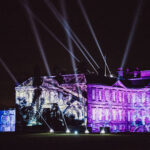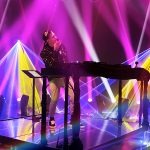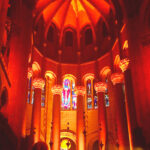Once upon a time, by the sea in a western land called L.A., before the creation of the Electronic Entertainment Expo (E3), there was a gathering called the Consumer Electronics Show (CES). Great in size and broad in scope, much confusion reigned, for the leaders who ran it had no idea about what do about a village of “video games.” The video game players would gaze on the latest innovations in car alarms, refrigerators, stereos, and telephones imploring in despair, “Where are our games?”
One winter in 1991, CES gathered in the windy midlands of Chicago. The loyal video game seekers had to trudge to the very edges of the festival, far from the main events, to a large tent, which held their village. In despair, they beheld their games ruined and unplayable from the rain that leaked through the tattered canvas. “This cannot go on!” the gamers cried, vowing to build their own village and never return.
Meanwhile, in the Far East, the mighty Senate, who ruled the consumers and gamers looked down and said, “There is too much violence in these games. We must investigate!” The Senate, with great intentions and many a “Harrumph!” appointed a council to tame down the violence. Thus was rendered “The Plan.”
And The Plan became known as The Interactive Digital Software Association (IDSA), now known as the Electronic Software Association. With The Plan, the video gamers were set free to build their own village. The village became a tradeshow known as the Electronic Entertainment Expo (E3).
There was much rejoicing in the year of 1995.

Lightswitch and E3 Roots
Among the many lighting, set and sound designers that flocked to this creative bonanza were the principals and founders of Lightswitch, Norm Schwab and John Feathrstone.
“We have indeed been working for clients at E3 since the convention’s inception,” says Featherstone. “Our first two at the show were Nintendo and Sega, who at the time — remember this is pre X-Box, pre iPad, were two of the biggest exhibitors.”
This year, Nintendo’s 20,000 square feet of exhibit was entirely devoted to a single game — The Legend of Zelda: Breath of the Wild. The brief for the booth from producer, Ralph Miller Productions, was to recreate the game’s lighting looks to emphasize many of the environmental effects that make the game so impressive. To achieve this, the design team animated some of the scenic backgrounds with Viper Performance fixtures. These produced a canvas of clouds, water, and lightning bolts. High End DL.3 fixtures were selected to then recreate images of flying flocks of birds and magical streaks of light encircling a castle. Other projections from the media server portrayed scenes of lava flowing down volcano slopes.
Fellow principal at Lightswitch, Chris Medvitz, who shared lead design responsibilities with Schwab on the booth, says, “Nintendo conceived of a linear experience, where guests enter a theater space to watch a brief presentation and then are let loose into the game play area. This is broken up into several areas themed around different aspects of the game.” The overall experience was like stepping into the game itself.
Among the gigantic printed backdrops, elaborate scenery, props and characters recreated from the fantasy, Nintendo placed 140 game stations. Guests could activate sensors embedded in the floor, thus bringing some of the key story elements to life through practical sound and lighting effects. Medvitz and Schwab lit the area from overhead truss and integrated lighting into the environmental elements. The lighting ran on a 40-minute loop, cycling from sunrise to sunset and back again, punctuated by the occasional thunderstorm.
“Our creative approach to this was much like lighting a theme park attraction,” adds Medvitz, a design discipline for which Lightswitch has a varied and rich background. Just to name a few are The Simpson Ride in Universal City, CA, and two in Orlando, FL: 5 Towers at Universal CityWalk and Men in Black: Alien Attack at Universal Studios Florida, which has been called the world’s first life-size, ride-through interactive video game experience.
As for the game play area at E3, Medvitz calls it “selfie central —that’s what the audience wants.”
There is also a fully functioning television studio positioned on the exterior of the exhibit space. Purposed for Nintendo’s press event activities, the broadcasts were live-streamed to the web throughout the day.
Along with the essential white key lighting, Lightswitch utilized colored lighting accents on the set and surrounding area. “We created about 20 different looks to help delineate the different game presentations,” Medvitz explains.
Programmer Benjamin Roy created the fully automated show on a full size grandMA2 via two streams of SMPTE and MIDI show control. This eliminated the necessity of an operator during the event, though Roy was onsite at the Nintendo Booth, should a need arise.

E3’s Twists and Turns
Although the Expo has set attendance records throughout its 20-year history, there were definite growing pains in its middle years. On July 31, 2006, the Entertainment Software Association (ESA) announced a restructured and downsized expo due to the overwhelming demand from exhibitors. E3, originally envisioned as an expo open only to game industry professionals, had grown over the years to include greater numbers of bloggers and attendees. The owners did not perceive these folks as “industry professionals.”
ESA announced that the new E3 would be by invitation only, which caused many of these people to be excluded.
Attendance to the 13th annual E3 summit in 2007 attracted only 10,000 attendees due to this scaled-back nature. The expo reached its nadir the following year in 2008 with only 5,000 attendees.
In 2009, the Expo reverted to the show’s previous format, which resulted in 41,000 attendees. The event turned out its highest numbers when held in Atlanta in 1998 with a record 70,000 attendees.
“We started designing the Electronic Arts (EA) press events around 2007 and 2008, during the couple years there was no trade show floor,” recalls Medvitz. “These events have grown from a small-scale affair at the Orpheum Theater to larger events at the Shrine Auditorium, and now this year, the entire EA branded E3 experience is being rebooted.”
John Featherstone picks up Lightswitch’s history with their EA client at this point.
“We have designed the booth for EA since 2012, working with Stephen Amato from Premier Displays,” Featherstone says. “As Chris says, this year the EA experience blossomed as ‘EA PLAY’. It is part trade show booth, part press event, part E-Sports event, part retail experience, and all new.”
EA’s agency of record, Cinco Design, handled the overall conceptual design strategy. EA then brought in two producers they have turned to for many years, due to the complex nature of EA Play. “Debra Robins of Plumbago Productions is the Executive producer for all the onstage and broadcast aspects,” says Medvitz, “and I am the lead designer for her part of the project. Stephen Amato is the executive producer for all the environmental areas, the portion of the project for which Featherstone is lead designer.”
For 2016, EA took over the entire Novo venue, which is adjacent to the E3 show floor across from the convention center. The Novo is located in what is known as “the center of the entertainment capital of the world — L.A. LIVE”. This included not just the stage, however. All of the public spaces, seating areas, hallways, terraces, and balconies took on brand elements of EA Play. A curated, carefully designed experience totally immersed guests from the moment they walked up to the facility, to the moment they left.
“The environment is a bit more complex than a traditional show floor booth,’ notes Featherstone, “as we are trying to give the attendees a sense of being in the game. There are many environmental elements like scenery, video, audio and lighting all working together to create an immersive multi sensory experience. We work hand in hand with Cinco and Premier’s design, as well as the rest of the technical team to create a unique experience that is attention getting, memorable, on brand, and ALL EA.”
“We put a lot of thought into creating a very architectural, detailed approach to the venue and the project,” says Featherstone, “ which is in stark contrast to the usual E3 ‘paint with a broad brush’ approach with trusses full of lights. We tucked fixtures into unusual spaces behind furniture and up into ceiling nooks and anywhere we could find.”
The design team accented architectural details with LED tape and LED “neon.” Featherstone had programmers Chris Merriman and Dennis Connors create “overall big, strong, bold, solid looks to capture a multi sensory experience. EA are a bold company with a definite vision and the lighting needed to reflect this,” he points out.
Merriman operated the grandMA2 that handled all stage activities on EA Play. Connors programmed ambient loops for the architecture throughout the remainder of the venue system on a separate grandMA2, with the exception of the Battlefield Theatre, which followed SMPTE from a d3 video server.
This year, attendance reached over 50,000 at the E3 convention, with an additional 20,000 attending the EA Play event at the Novo Theater.
And there was much rejoicing again as the players entered their newfound gamers’ village.
For more information on Lightswitch, go to www.lightswitch.net.

Lightswitch at E3 2016
Crew
- Nintendo Lighting Crew: Jeff Johnson, Robert Braccia, Ryan Morris, Vreje Bakalian
- EA Play Lighting Crew: John Stewart, Ryan Babroff, David Strause, Lacey Taylor
-
Nintendo – programmer Ben RoyEA – programmers Chris Merriman and Dennis ConnorsAssociate Designer Austin Shapley
Gear
Nintendo Booth:
- 2 grandMA2 full size consoles
- 2 grandMA2 on PC + command wing
- 60 Martin MAC Viper Performances
- 50 Martin MAC Quantum Profiles
- 35 Martin MAC Quantum Washes
- 130 Martin MAC Auras
- 15 Clay Paky Sharpys
- 2 Clay Paky Sharpy Washes
- 10 Elation SixPAR 200s
- 50 Chauvet COLORado 1 Solos
- 37 ChromaQ Color Force 72s
- 10 ChromaQ Color Force 12s
- 8 American DJ FlatPAR QA12X fixtures
- 12 Martin Atomic 3000 strobes
- 24 Star strobes
- 24 TMB PowerPARs
- 24 Arri SkyPanel LED S60-C fixtures
- 3 High End DL.3 digital lights
- 4 Ultratec Radiance hazers
- 4 ReelEFX ReFan 3s
- 230 Meters of RGBW LED tape
EA PLAY (Stage):
- 2 grandMA2 Light consoles
- 16 Martin MAC Viper Performances
- 43 Robe Pointes
- 35 Robe 600 LED Washes
- 14 Robe 100 LED Beams
- 38 Martin RUSH PAR2s
- 14 ChromaQ Color Force 72s
- 4 ChromaQ Color Force 48s
- 4 Color Kinetics Color Blaze TRX48s
- 10 KinoFlow Celeb 400 LED fixtures
- 8 DeSisti Super LED F6 DL Fresnels
- 2 Ultratec Radiance hazers
- 2 ReelEFX Refan 2s
- 64 LightGear LightStix Pro units
- 48 Meters of RGB LED tape
EA PLAY (Environment):
- 2 grandMA2 Light consoles w/ 17” monitors
- 64 GLP impression X4s
- 66 Martin RUSH PAR 2 Zooms
- 19 Martin RUSH PAR 1 RGBW fixtures
- 2 Martin MAC Viper Performances
- 16 Elation Volt Q5s
- 10 ETC Source Four Lustr 2s (90°)
- 12 Chroma-Q ColorCharge Plus units
- 30 Chroma-Q ColorForce 48s
- 20 Chroma-Q ColorForce 12s
- 8 Chauvet Nexus 4×4 (6 LED panels on stands)
- 28 Coemar StripLite LED fixtures
- 41 Coemar LED PARs
- 50 Star Strobes
- 2 DF-50 hazers
- RGBW & cool white LED tape
- 2 150’ rolls of cool white LED “neon” w/10 flexible connectors + six power ins
- 500’ RGBW LED tape
- 6 DMX converters
- Truss and Structures:
- 2 12” x 12” Tomcat Truss 10’
- 4 12” x 12” Tomcat Truss 8’
- 2 12” x 12” Tomcat Truss 3’
- 2 12”x 12” Tomcat Truss Corner
- 4 Floor base units for truss verticals
- 8 50 lb. base units
- 158’ Pipe


